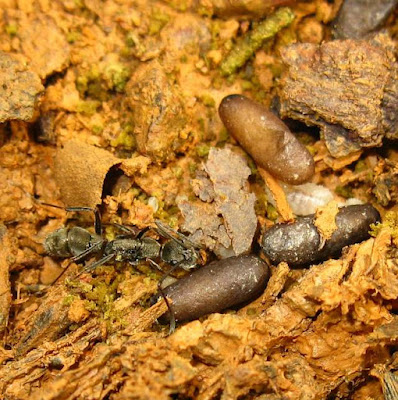Diacamma is a "queenless" genus of ant where one of the workers, exactly identical in physiological characteristics as the other female workers except that she is fertile and has been fertilised by a male alate, takes on the sole role of reproduction in the nest.
This egg laying worker is called a garmergate. Typically the nest of Diacamma is small consisting of some fifty to sixty workers. Males are produced continuously in small numbers when the nest has matured (reached a certain number of individuals). The male usually leave the nest a couple of days after emerging from its cocoon.
Female workers, may be fertilized by a male. Typically a fertile female will stand outside her nest lifting up her abdomen opening up its end releasing a scent to attract males nearby. While the garmergate is present in a nest no other female will begin to lay eggs. But once she is removed for whatever reasons after a number of days another fertilised female will begin to lay eggs taking over as the new garmergate. Even unfertilised workers will lay eggs. In a group of unfertilised workers, after a certain time without the presence of a fertile egg laying garmergate, one of these workers will begin to lay eggs. Even if non of them were mated during this period.
The Diacamma garmergates or "queens" are non imago queens and do not have the three simple eyes and larger thorax that is common among most ants' queen.
A small nest of Diacamma sp. ant probably Diacamma rugosum.
Garmergate (egg laying worker) of Diacamma sp.
Diacamma ant tandem run. This normally happens when the colony move nest as the newly eclosed workers and also the garmagate is led by the workers to their new nest. Note the tandem pair cross path with a Odontoponera transversa queen foraging.
Worker ant of Diacamma sp.
Worker of Diacamma sp.
Worker of Diacamma sp.
Worker of Diacamma sp.
Worker of Diacamma sp.
Worker of Diacamma sp.
Worker of Diacamma sp.
Worker of Diacamma sp.
Worker of Diacamma sp.
Diacamma workers with the baton shaped eggs.

Close up of Diacamma worker with the baton shaped eggs.
Only male are "born" with wings.
These wasplike males will leave the nest one or two days after they eclosed. They are not even fed by their sisters.
The nest opening of Diacamma.
Nest of Diacamma ants are typically small with no more than around fifty ants. The nest generally occupy an area no more that 30 by 30 centimeter and not much deeper than 10 centimeter.
The nest also have a waste dump area populated with numerous commensalistic arthropods such as springtails, mites, small millipedes species and sow bugs. These keep the nest free of dead unconsumed organic material.
Two Diacamma ants in a death fight.
A Diacamma ants battle. Two nest of Diacamma engage in warfare.
Nest of Diacamma ants are typically small with no more than around fifty ants. The nest generally occupy an area no more that 30 by 30 centimeter and not much deeper than 10 centimeter.
The nest also have a waste dump area populated with numerous commensalistic arthropods such as springtails, mites, small millipedes species and sow bugs. These keep the nest free of dead unconsumed organic material.
Two Diacamma ants in a death fight.
A Diacamma ants battle. Two nest of Diacamma engage in warfare.
Diacamma baguiense
Mimicry
Mimicry in invertebrates are common. Here a Polyrhachis ant species that mimic Diacamma.
Polyrhachis ant species that mimic Diacamma.
An assassin bug that mimic Diacamma ants.
Taxonomy:
Subfamily: Ponerinae
Genus: Diacamma
First Posted: 2009 09 08
© 2009 – 2021 Quah. All rights reserved.



























